The Fourth Man (1)
By:
April 18, 2015
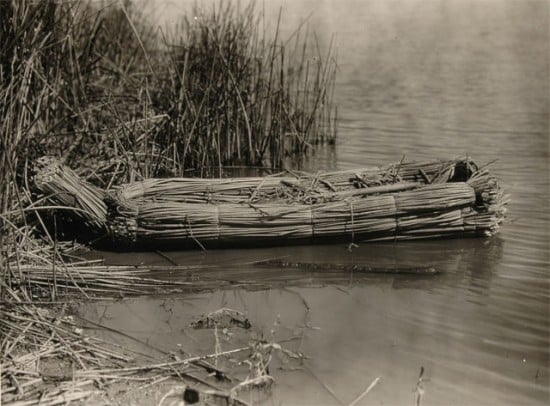
From the nineteen-teens until his death in 1956, American author and explorer John Russell wrote dozens of adventure yarns for such magazines as The Golden Book, Argosy, and The Saturday Evening Post. I first came across “The Fourth Man” (Collier’s, Jan 6. 1917) in The Pocket Book of Adventure Stories (1945, ed. Philip Van Doren Stern), when I was an adolescent in the early ’80s. It’s one of the greatest tales of suspense ever. Enjoy!
The raft might have been taken for a swath of cut sedge or a drifting tangle of roots as it slid out of the shadowy river mouth at dawn and dipped into the first ground swell. But while the sky brightened and the breeze came fresh offshore it picked a way among shoals and swampy islets with purpose and direction, and when at last the sun leaped up and cleared his bright eye of the morning mist it had passed the wide entrance to the bay and stood to open sea.
It was a curious craft for such a venture, of a type that survives here and there in the obscure corners of the world. The coracle maker would have scorned it. The first navigating pithecanthrope built nearly as well with his log and bush. A mat of pandanus leaves served for its sail and a paddle of niaouli wood for its helm. But it had a single point of real seaworthiness. Its twin floats, paired as a catamaran, were woven of reed bundles and bamboo sticks upon triple rows of bladders. It was light as a bladder itself, elastic, fit to ride any weather. One other quality this raft possessed which recommended it beyond all comfort and all safety to its present crew. It was very nearly invisible. They had only to unstep its mast and lie flat in the cup of its soggy platform and they could not be spied half a mile away.
Four men occupied the raft. Three of them were white. Their bodies had been scored with brambles and blackened with dried blood, and on wrist and ankle they bore the dark and wrinkled stain of the gyves. The hair upon them was long and matted. They wore only the rags of blue canvas uniforms. But they were whites, members of the superior race — members of a highly superior race according to those philosophers who rate the criminal aberration as a form of genius.
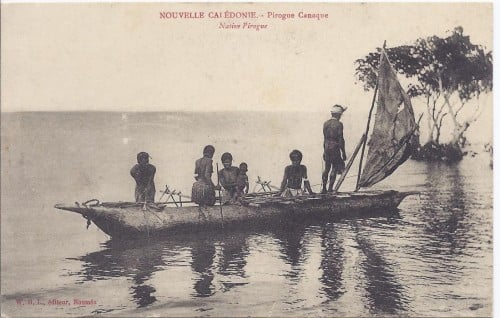
The fourth was the man who had built the raft and was now sailing it. There was nothing superior about him. His skin was a layer of soot. His prognathous jaw carried out the angle of a low forehead. No line of beauty redeemed his lean limbs and knobby joints. Nature had set upon him her plainest stamp of inferiority, and his only attempts to relieve it were the twist of bark about his middle and the prong of pig ivory through the cartilage of his nose. Altogether a very ordinary specimen of one of the lowest branches of the human family — the Canaques of New Caledonia.
The three whites sat together well forward, and so they had sat in silence for hours. But at sunrise, as if some spell had been raised by the clang of that great copper gong in the east, they stirred and breathed deep of the salt air and looked at one another with hope in their haggard faces, and then back toward the land which was now no more than a gray-green smudge behind them…. “Friends,” said the eldest, whose temples were bound with a scrap of crimson scarf, “Friends — the thing is done.”
With a gesture like conjuring he produced from the breast of his tattered blouse three cigarettes, fresh and round, and offered them.
“Nippers!” cried the one at his right. “True nippers — name of a little good man! And here? Doctor, I always said you were a marvel. See if they be not new from the box!”
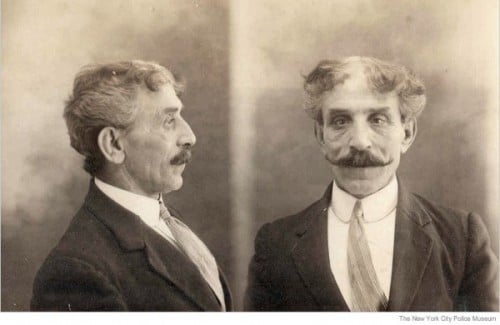
Dr. Dubosc smiled. Those who had known him in very different circumstances about the boulevards, the lobbies, the clubs, would have known him again and in spite of all disfigurement by that smile. And here, at the bottom of the earth, it had set him still apart in the prisons, the cobalt mines, the chain gangs of a community not much given to mirth. Many a crowded lecture hall at Montpellier had seen him touch some intellectual firework with just such a twinkle behind his bristly gray brows, with just such a thin curl of lip.
“By way of celebration,” he explained. “Consider. There are seventy-five evasions from Nouméa every six months, of which not more than one succeeds. I had the figures myself from Dr. Pierre at the infirmary. He is not much of a physician, but a very honest fellow. Could anybody win on that percentage without dissipating? I ask you.”
“Therefore you prepared for this?”
“It is now three weeks since I bribed the night guard to get these same nippers.”
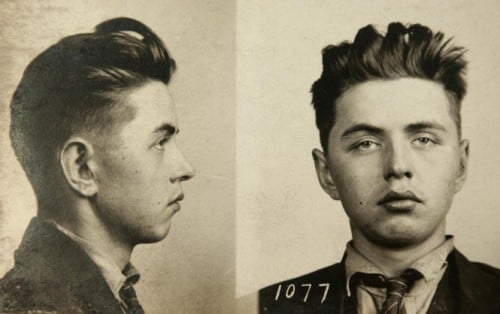
The other regarded him with admiration. Sentiment came readily upon this beardless face, tender and languid, but overdrawn, with eyes too large and soft and oval too long. It was one of those faces familiar enough to the police which might serve as model for an angel were it not associated with some revolting piece of deviltry. Fenayrou himself had been condemned “to perpetuity” as an incorrigible.
“Is not our doctor a wonder?” he inquired as he handed a cigarette along to the third white man. “He thinks of everything. You should be ashamed to grumble. See — we are free, after all. Free!”
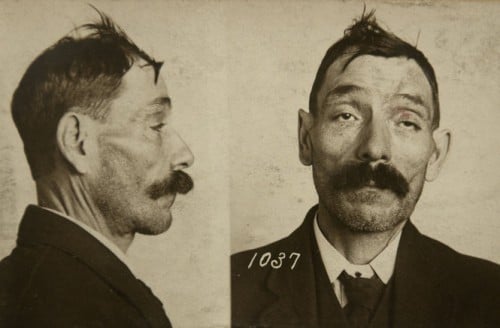
The third was a gross, pock-marked man with hairless lids known sometimes as Niniche, Trois Huit, Le Tordeur, but chiefly among copains as Perroquet — a name derived perhaps from his beaked nose, or from some perception of his jailbird character. He was a garroter by profession, accustomed to rely upon his fists only for the exchange of amenities. Dubosc might indulge a fancy and Fenayrou seek to carry it as a pose, but The Parrot remained a gentleman of strictly serious turn. There is perhaps a tribute to the practical spirit of penal administration in the fact that while Dubosc was the most dangerous of these three and Fenayrou the most depraved, Perroquet was the one with the official reputation, whose escape would be signaled first among the “Wanted.” He accepted the cigarette because he was glad to get it, but he said nothing until Dubosc passed a tin box of matches and the first gulp of picadura filled his lungs….
RADIUM AGE SCIENCE FICTION: “Radium Age” is HILOBROW’s name for the 1904–33 era, which saw the discovery of radioactivity, the revelation that matter itself is constantly in movement — a fitting metaphor for the first decades of the 20th century, during which old scientific, religious, political, and social certainties were shattered. This era also saw the publication of genre-shattering writing by Edgar Rice Burroughs, Sax Rohmer, E.E. “Doc” Smith, Jack London, Arthur Conan Doyle, Aldous Huxley, Olaf Stapledon, Karel Čapek, H.P. Lovecraft, Charlotte Perkins Gilman, Yevgeny Zamyatin, Philip Gordon Wylie, and other pioneers of post-Verne/Wells, pre-Golden Age “science fiction.” More info here.
READ GORGEOUS PAPERBACKS: HiLoBooks has reissued the following 10 obscure but amazing Radium Age science fiction novels in beautiful print editions: Jack London’s The Scarlet Plague, Rudyard Kipling’s With the Night Mail (and “As Easy as A.B.C.”), Arthur Conan Doyle’s The Poison Belt, H. Rider Haggard’s When the World Shook, Edward Shanks’ The People of the Ruins, William Hope Hodgson’s The Night Land, J.D. Beresford’s Goslings, E.V. Odle’s The Clockwork Man, Cicely Hamilton’s Theodore Savage, and Muriel Jaeger’s The Man with Six Senses. For more information, visit the HiLoBooks homepage.
SERIALIZED BY HILOBOOKS: Jack London’s The Scarlet Plague | Rudyard Kipling’s With the Night Mail (and “As Easy as A.B.C.”) | Arthur Conan Doyle’s The Poison Belt | H. Rider Haggard’s When the World Shook | Edward Shanks’ The People of the Ruins | William Hope Hodgson’s The Night Land | J.D. Beresford’s Goslings | E.V. Odle’s The Clockwork Man | Cicely Hamilton’s Theodore Savage | Muriel Jaeger’s The Man With Six Senses | Jack London’s “The Red One” | Philip Francis Nowlan’s Armageddon 2419 A.D. | Homer Eon Flint’s The Devolutionist | W.E.B. DuBois’s “The Comet” | Edgar Rice Burroughs’s The Moon Men | Charlotte Perkins Gilman’s Herland | Sax Rohmer’s “The Zayat Kiss” | Eimar O’Duffy’s King Goshawk and the Birds | Frances Hodgson Burnett’s The Lost Prince | Morley Roberts’s The Fugitives | Helen MacInnes’s The Unconquerable | Geoffrey Household’s Watcher in the Shadows | William Haggard’s The High Wire | Hammond Innes’s Air Bridge | James Branch Cabell’s Jurgen | John Buchan’s “No Man’s Land” | John Russell’s “The Fourth Man” | E.M. Forster’s “The Machine Stops” | John Buchan’s Huntingtower | Arthur Conan Doyle’s When the World Screamed | Victor Bridges’ A Rogue By Compulsion | Jack London’s The Iron Heel | H. De Vere Stacpoole’s The Man Who Lost Himself | P.G. Wodehouse’s Leave It to Psmith | Richard Connell’s “The Most Dangerous Game” | Houdini and Lovecraft’s “Imprisoned with the Pharaohs” | Arthur Conan Doyle’s “The Sussex Vampire”.
ORIGINAL FICTION: HILOBROW has serialized three novels: James Parker’s The Ballad of Cocky The Fox (“a proof-of-concept that serialization can work on the Internet” — The Atlantic); Karinne Keithley Syers’s Linda Linda Linda (which includes original music); and Robert Waldron’s roman à clef The School on the Fens. We also publish original stories and comics. These include: Matthew Battles’s stories “Gita Nova“, “Makes the Man,” “Imago,” “Camera Lucida,” “A Simple Message”, “Children of the Volcano”, “The Gnomon”, “Billable Memories”, “For Provisional Description of Superficial Features”, “The Dogs in the Trees”, “The Sovereignties of Invention”, and “Survivor: The Island of Dr. Moreau”; several of these later appeared in the collection The Sovereignties of Invention | Peggy Nelson’s “Mood Indigo“, “Top Kill Fail“, and “Mercerism” | Annalee Newitz’s “The Great Oxygen Race” | Flourish Klink’s Star Trek fanfic “Conference Comms” | Charlie Mitchell’s “A Fantasy Land” | Charlie Mitchell’s “Sentinels” | Joshua Glenn’s “The Lawless One”, and the mashup story “Zarathustra vs. Swamp Thing” | Adam McGovern and Paolo Leandri’s Idoru Jones comics | John Holbo’s “Sugarplum Squeampunk” | “Another Corporate Death” (1) and “Another Corporate Death” (2) by Mike Fleisch | Kathryn Kuitenbrouwer and Frank Fiorentino’s graphic novel “The Song of Otto” (excerpt) | John Holbo’s graphic novel On Beyond Zarathustra (excerpt) | “Manoj” and “Josh” by Vijay Balakrishnan | “Verge” by Chris Rossi, and his audio novel Low Priority Hero | EPIC WINS: THE ILIAD (1.408-415) by Flourish Klink | EPIC WINS: THE KALEVALA (3.1-278) by James Parker | EPIC WINS: THE ARGONAUTICA (2.815-834) by Joshua Glenn | EPIC WINS: THE MYTH OF THE ELK by Matthew Battles | TROUBLED SUPERHUMAN CONTEST: Charles Pappas, “The Law” | CATASTROPHE CONTEST: Timothy Raymond, “Hem and the Flood” | TELEPATHY CONTEST: Rachel Ellis Adams, “Fatima, Can You Hear Me?” | OIL SPILL CONTEST: A.E. Smith, “Sound Thinking | LITTLE NEMO CAPTION CONTEST: Joe Lyons, “Necronomicon” | SPOOKY-KOOKY CONTEST: Tucker Cummings, “Well Marbled” | INVENT-A-HERO CONTEST: TG Gibbon, “The Firefly” | FANFICTION CONTEST: Lyette Mercier’s “Sex and the Single Superhero”
